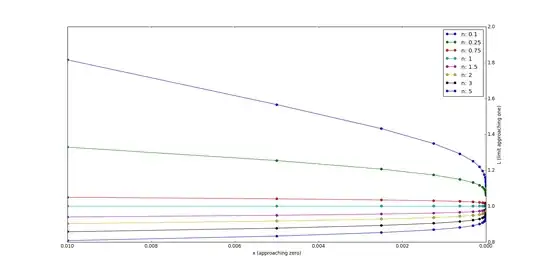I am trying to obtain $$\lim_{x\to0}\frac{\Phi^{-1}(1-x)}{\Phi^{-1}(1-x/n)}$$ where $\Phi^{-1}$ is the inverse cdf of the standard normal distribution and $n>0$. As there is an indeterminate form ($\infty/\infty$), I am applying l'Hôpital's rule, but the resulting expression (I mean, of the derivatives of both the numerator and denominator) is of the form $\infty/\infty$ as well. Would you give me any advice on how to proceed?
2 Answers
This answer is not complete and needs correction. I am stuck at a point and will update this answer soon. However, I am retaining this answer in hope that someone might state more clearly the transition from equation (a) to equation (b).
$$1-x = \Phi(t) = \frac{1}{2} + \frac{1}{2}\text{erf}\left(\frac{t}{\sqrt{2}}\right) \implies \Phi^{-1}(1-x) = \sqrt{2}\ \text{erf}^{-1}(1-2x)$$
Similarly,
$$\Phi^{-1}\left(1-\frac{x}{n}\right) = \sqrt{2}\ \text{erf}^{-1}\left(1-\frac{2x}{n}\right)$$
where,
$$\text{erf}^{-1}(u) = \sum_{k=0}^{\infty}\frac{c_k(\sqrt{\pi}/2)^{2k+1}}{2k+1}u^{2k+1}$$
Note that $\text{erf}^{-1}(0) = 0$.
$$\begin{align}\lim_{x\rightarrow 0} \frac{\Phi^{-1}(1-x)}{\Phi^{-1}\left(1-\frac{x}{n}\right)} &= \lim_{x\rightarrow 0} \frac{\sqrt{2}\ \text{erf}^{-1}(1-2x)}{\sqrt{2}\ \text{erf}^{-1}\left(1-\frac{2x}{n}\right)} = \lim_{x\rightarrow 0} \frac{ \text{erf}^{-1}(1-2x)}{\ \text{erf}^{-1}\left(1-\frac{2x}{n}\right)}-1+1 \\\\ &= \lim_{x\rightarrow 0} \frac{ \text{erf}^{-1}(1-2x) - \text{erf}^{-1}\left(1-\frac{2x}{n}\right)}{\text{erf}^{-1}\left(1-\frac{2x}{n}\right)}+1 \\\\ &= \lim_{x\rightarrow 0} \frac{\sum_{k=0}^{\infty}\frac{c_k(\sqrt{\pi}/2)^{2k+1}}{2k+1}\left((1-2x)^{2k+1} - \left(1-\frac{2x}{n}\right)^{2k+1}\right)}{\text{erf}^{-1}\left(1-\frac{2x}{n}\right)} + 1\\\\ &= \lim_{x\rightarrow 0} \frac{\sum_{k=0}^{\infty}\frac{c_k(\sqrt{\pi}/2)^{2k+1}}{2k+1}\left(2x(\frac{1}{n}-1)(\sum_{i=0}^{2k}(1-2x)^{i}(1-\frac{2x}{n})^{2k-i})\right)}{\text{erf}^{-1}\left(1-\frac{2x}{n}\right)} + 1 \\\\ &= \frac{\sum_{k=0}^{\infty}\frac{c_k(\sqrt{\pi}/2)^{2k+1}}{2k+1}\left((\rightarrow 0)(\rightarrow (2k+1)\right)}{\rightarrow \infty} + 1 \tag{a} \\\\ &= \rightarrow 0 + 1 = 1 \tag{b} \end{align}$$
Note: How did I get ($\rightarrow 0$)? It turns out that the numerator can be upper bounded by $2x(1/n-1)$ times derivative of $\text{ erf}^{-1}(u)$ evaluated at $u=(1-2x/\max(1,n))$, where $x \rightarrow 0$. Now, although the numerator has form of $(\rightarrow 0)(\rightarrow \infty)$ and the denominator is tending to $\infty$ as $x \rightarrow 0$. Near $0^+$, the rate(speed) with which the denominator is tending to $\infty$ is much faster than the rate at which numerator is tending to $\infty$ due to the multiplication of $(\rightarrow 0)$ in the numerator. I observed this by plotting the function for different values of $n$ and the function is approaching $0$ as $x \rightarrow 0$. However, concretely proving this seems to me to be non trivial.
Some equations that might be useful to solve.
$$\frac{\partial \text{ erf}^{-1}(u)}{\partial u} = \sum_{k=0}^{\infty}c_k(\sqrt{\pi}/2)^{2k+1}u^{2k} = \frac{\sqrt{\pi}}{2}e^{(\text{erf}^{-1}(u))^2}$$
$$\lim_{u\rightarrow 0}u\frac{\partial \text{ erf}^{-1}(u)}{\partial u} = \lim_{u\rightarrow 0} \sum_{k=0}^{\infty}c_k(\sqrt{\pi}/2)^{2k+1}u^{2k+1} = \lim_{u\rightarrow 0}u\frac{\sqrt{\pi}}{2}e^{(\text{erf}^{-1}(u))^2} = (\rightarrow 0)(\rightarrow \sqrt{\pi}/2)$$
Check this wiki page for more information on $\text{erf}^{-1}$ and its taylor series.
Check this wolfram page for a closed formula for the derivative of $\text{erf}^{-1}(u)$. It is easy to derive it from the definition of $\text{erf}^{-1}(u)$ in the integral form.
With simulations using different values of $n$, I get convergence to $1$.
- 5,216
Here is another much simpler way to solve.
Note that,
$$\frac{\partial \Phi^{-1}(x)}{\partial x} = \frac{1}{\phi(\Phi^{-1}(x))} \ \ \text{ and } \ \ \frac{\partial \Phi^{-1}(x/n)}{\partial x} = \frac{1}{n\phi(\Phi^{-1}(x/n))}$$
Also,
$$\frac{\partial \phi(\Phi^{-1}(x))}{\partial x} = \frac{-\Phi^{-1}(x)\phi(\Phi^{-1}(x))}{\phi(\Phi^{-1}(x))} = -\Phi^{-1}(x) $$
$$ \frac{\partial \phi(\Phi^{-1}(x/n))}{\partial x} = \frac{-\Phi^{-1}(x/n)\phi(\Phi^{-1}(x/n))}{n\phi(\Phi^{-1}(x/n))} = -\frac{\Phi^{-1}(x/n)}{n}$$
$$\begin{align} L &= \lim_{x \rightarrow 0} \frac{\Phi^{-1}(1-x)}{\Phi^{-1}(1-x/n)} = \lim_{x \rightarrow 0} \frac{-\Phi^{-1}(x)}{-\Phi^{-1}(x/n)} = \color{red}{\lim_{x \rightarrow 0} \frac{\Phi^{-1}(x)}{\Phi^{-1}(x/n)}} = \frac{\rightarrow -\infty}{\rightarrow -\infty}\\\\ &= \lim_{x \rightarrow 0} \frac{\frac{\partial \Phi^{-1}(x)}{\partial x}}{\frac{\partial \Phi^{-1}(x/n)}{\partial x}} = \lim_{x \rightarrow 0} \frac{n\phi(\Phi^{-1}(x/n))}{\phi(\Phi^{-1}(x))} = \frac{\rightarrow 0}{\rightarrow 0} \\\\ &= \lim_{x \rightarrow 0} \frac{n\frac{\partial \phi(\Phi^{-1}(x/n))}{\partial x}}{\frac{\partial \phi(\Phi^{-1}(x))}{\partial x}} = \color{red}{\lim_{x \rightarrow 0} \frac{\Phi^{-1}(x/n)}{\Phi^{-1}(x)}} = 1/L \end{align}$$
Therefore,
$$L^2 = 1 \implies L = \pm 1$$
Clearly, $L$ cannot be negative, so $L=1$.
- 5,216
-
-
-
I have one question: $\frac{\partial \Phi^{-1}(x)}{\partial x}=\frac{\partial \Phi^{-1}(1-x)}{\partial x}$? – Cromack Jul 12 '17 at 17:29
-
Where did I use it? Note that $\Phi(-y) = 1 - \Phi(y)$. Take $y = \Phi^{-1}(x)$ to get $\Phi(-\Phi^{-1}(x)) = 1 - x \implies -\Phi^{-1}(x) = \Phi^{-1}(1-x)$ – Dhruv Kohli Jul 12 '17 at 17:34
-
-
-
-
Sorry for coming back to the proof. How did you obtain $\frac{\partial\phi(\Phi^{-1}(x))}{\partial x}?$ Isn't it $\frac{\phi^\prime(\Phi^{-1}(x))}{\phi(\Phi^{-1}(x))}$? Then, is $\phi^\prime(\Phi^{-1}(x))=-\Phi^{-1}(x)\phi(\Phi^{-1}(x))$? – Cromack Jul 13 '17 at 07:53
-
Yes. $\phi'(x) = -x\phi(x)$, so $\phi'(f(x)) = -f(x)\phi(f(x))f'(x)$ – Dhruv Kohli Jul 13 '17 at 07:57
-
Sorry for bothering you again. Do you think you can perform the last step ($L^2=1$) taking into account that it's a $\infty / \infty$ indeterminate form? – Cromack Jul 13 '17 at 19:59
-
Yes we can. The form of the limit has nothing to do with that. If $L = \lim_{x\rightarrow 0}\frac{f(x)}{g(x)}$ comes out to be zero or finite non-zero or infinite value then the limit $L' = \lim_{x\rightarrow 0}\frac{g(x)}{f(x)}$ will be $1/L$ and its value will be infinite or finite non-zero or zero. – Dhruv Kohli Jul 13 '17 at 20:10
-
Precisely, you don't know if $\lim_{x\to0}\frac{f(x)}{g(x)}$ comes out to be zero or finite non-zero or infinite value, because there is an $\infty/\infty$ indeterminate form. – Cromack Jul 14 '17 at 06:06
-
Yes. We don't know that. But whatever the value of limit be, the value of $\lim_{x\rightarrow 0} \frac{g(x)}{f(x)}$ will be the inverse of the former value. And I proved that the two values $L$ and $L^{-1}$ are equal. – Dhruv Kohli Jul 14 '17 at 06:09
-
CHeck this https://math.stackexchange.com/questions/939852/the-limit-of-reciprocal-is-the-reciprocal-of-the-limit – Dhruv Kohli Jul 14 '17 at 06:14
-
So, for example, if you had proved that $\lim_{x\to0}\frac{g(x)}{f(x)}=\lim_{x\to0}\frac{f(x)}{f(x)}$, although it is an $\infty/\infty$ indeterminate form ($\lim_{x\to0}f(x)=\infty=\lim_{x\to0}g(x)$), would the result be 1, in that case? – Cromack Jul 14 '17 at 07:42
-
I believe you meant $\frac{f(x)}{g(x)}$ on RHS. Yes the result will be $1$. – Dhruv Kohli Jul 14 '17 at 08:01

$\lim_{x\to0}\sum_{k=0}^\infty c_k\left(\frac{\sqrt{\pi}}{2}\right)^{2k+1}xR\frac{S}{2k+1}$, where $R=2(1/n-1)$ and $S$ is the sum from $0$ to $2k$. That limit is equal to $\lim_{x\to0}\sum_{k=0}^\infty\frac{\partial\mathrm{erf}^{-1}(x)}{\partial x}\frac{1}{x^{2k-1}}R\frac{S}{2k+1}=(\to\frac{\sqrt{\pi}}{2})(\to1/\infty=0)(\to R)(\to 1)=0$. Is that correct?
– Cromack Jul 12 '17 at 11:01